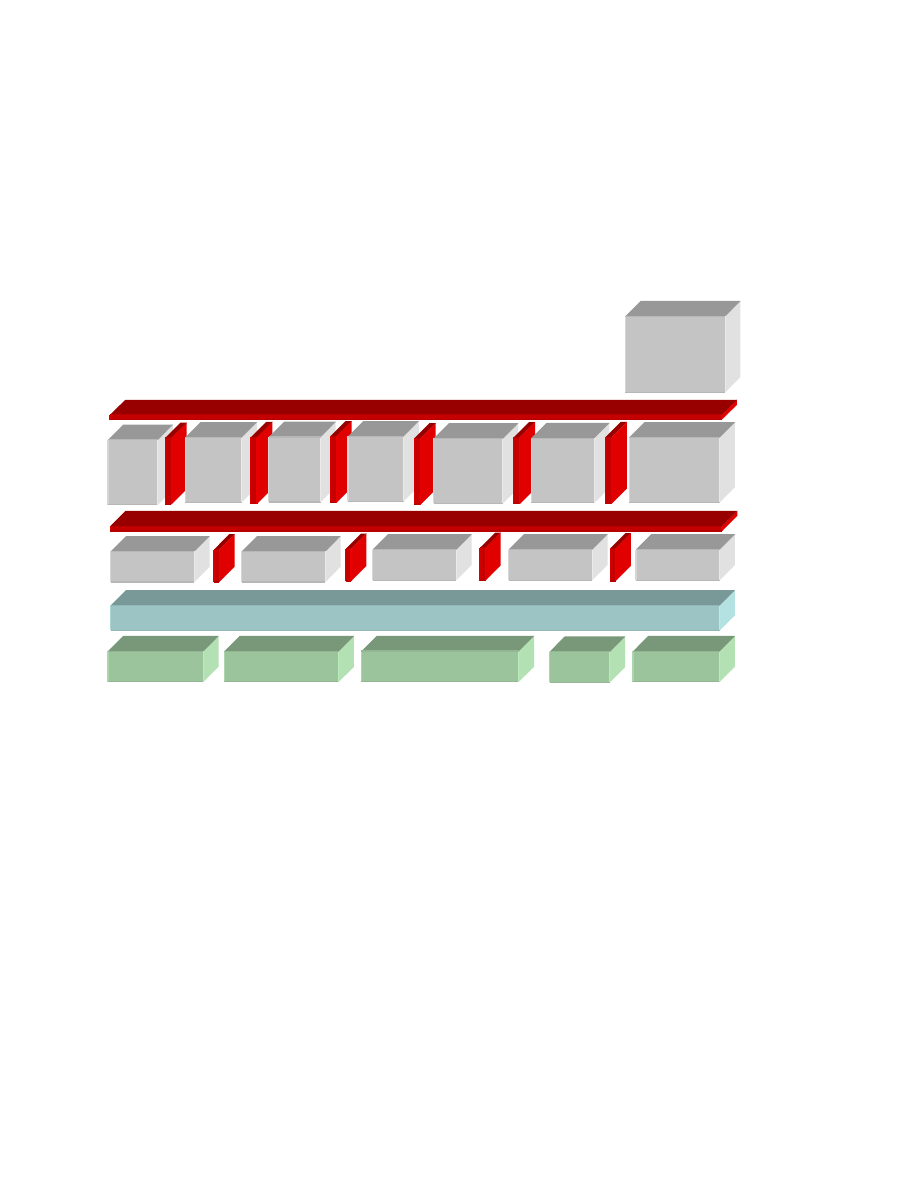
1
OpenTC Newsletter
April 2009
From the Open Trusted Computing (OpenTC) research project, sponsored by the European
Union.
In this issue:
-
Editorial: Fighting theft of confidential information
-
A hypervisor against ferrying away data
-
A Secure Wallet for a mobile Trusted Platform
-
Standardizing a Java API for Trusted Computing, the open way
-
Recent OpenTC publications
Editorial: Fighting theft of confidential information
By: Arnd Weber, ITAS, Forschungszentrum Karlsruhe, Germany
Dear Reader,
It has been a while since we sent out the last newsletter. We are making up for the wait with
three interesting articles:
We start with an interview that addresses how a secure hypervisor can help to protect against
economic espionage. In “A hypervisor against ferrying away data” Chris Dalton from Hewlett
Packard Laboratories, UK, not only addresses the future development of threats, but also how
a hypervisor architecture as produced by OpenTC could help, what progress has been made in
the project, and what the remaining issues are for the future.
In addition, we present work on virtualisation for small, mobile devices. In “A Secure Wallet
for a mobile Trusted Platform” a mechanism is presented for keeping user authentication data
protected, such as passwords. The article is written by Eckhard Delfs, Comneon, Germany,
Eimear Gallery, Royal Holloway, UK, David Jennings, Infineon, Germany, and Hans Löhr,
Ruhr University, Germany.
OpenTC project partners IAIK (Graz University of Technology, Austria), Portakal Teknoloji
(Turkey) and the University of Cambridge (UK) lead the creation of the Java Standard API
for Trusted Computing, the Java Specification Request # 321. Now a draft of the
specifications is openly available for review and comments are asked for. See the article by
Ronald Toegl of IAIK on “Standardizing a Java API for Trusted Computing, the open way” to
learn more.
Let me take the opportunity of writing this editorial to announce a Common Criteria V3.1
Protection Profile for a “High Assurance Security Kernel”. This document can be used to
evaluate future kernels, for instance, products using the OpenTC architecture. It was produced
by the OpenTC partner Ruhr University, together with Sirrix AG, atsec information security
and the German Federal Office for Information Security (BSI) (see [1] and [2] for details).

2
As usual, we close with an announcement of new research papers published by members of
the OpenTC consortium. It is a long list because it covers nine months. The reason why you
had to wait for this newsletter is that we are preparing the publication of our final proof of
concept demonstrators – stay tuned!
References:
[1] Sirrix AG: High-Assurance Security Kernel EAL 5 Protection Profile, according to the
Common Criteria v3.1 R2, 2007, certified by the Federal Office for Information
Security (BSI). 2008. www.sirrix.com/media/downloads/54500.pdf
[2] Löhr, Hans; Sadeghi, Ahmad-Reza; Stüble, Christian; Weber, Marion; Winandy, Marcel:
Modeling Trusted Computing Support in a Protection Profile for High Assurance Security
Kernels. TRUST 2009, April 2009.
Contact: arnd.weber (at) itas.fzk.de
Acknowledgements: Our thanks go to Alison Hepper, Dirk Kuhlmann and Herbert
Petautschnig for their help in preparing this issue.
A hypervisor against ferrying away data
Interview with Chris Dalton, Hewlett Packard Laboratories, Bristol, UK
Which threats can be countered by the kind of hypervisor being built by the OpenTC
consortium? This is first question addressed in the interview, which subsequently discusses
how these threats can be reduced, what progress has been made here in the project, and what
the remaining future issues are. Chris Dalton from Hewlett Packard, who worked on the
project from the beginning, was interviewed by Franco Furger and Arnd Weber from ITAS,
Forschungszentrum Karlsruhe, Germany, on January 27, 2009, in Bristol, UK.
Arnd: Do you think there are certain risks or attacks which have already occurred that could
be addressed with a hypervisor-like approach?
In general, I think the answer is “yes”. Code is always going to have bugs that can be
potentially compromised. The big thing that virtualisation brings is the ability to
compartmentalise, to contain environments. This puts boundaries around that code. You
accept that some code can be compromised, but you have, if you like, a ring-fence around it to
defend against those compromises. An example would be a platform with Vista running on
top of the virtualisation layer. Even if somebody manages to compromise Vista, which is
likely, given its size – 50 million lines of code I think – there is a chance that you could have
supplementary controls, within the virtualisation layer itself. Even if Vista is compromised,
those controls are still effective.
Arnd: If there were an attack on Vista, how would virtualisation help?
Some of the attacks that we are aware of involve compromise of an end-user’s platform. Data
from that end-user system are then ferried away to a remote location.
If you had network controls that were outside Vista, but enforced by the virtualisation layer,
they would then have to compromise both Vista and your virtualisation layer. In that regard –

3
as a simple example – virtualisation could be quite useful for to setting up a network policy
which remains in place even if Vista is compromised.
Moving forward, users want to use applications. They do not care so much about the actual
operating system. For example, if you are using a web browser, I don’t think you particularly
care whether it is running under Windows or Linux. Similarly with something like iTunes, it
would be nice if it were running on Linux as well as Mac/Windows. The user is interested in
the application, not the operating system. With virtualisation, you could provide the
applications separately. For example, you could have one virtual machine running your
iTunes application, you might have one running your web browser, and you might have your
office suite. In that way again, you manage to partition the amount of code that is in any
particular environment. Hopefully, then you can contain any damage if your office suite is
compromised.
The big challenge – and this is something we have been struggling with at HP for a number of
years – is that isolation itself isn’t that useful. You need isolation plus controlled sharing, and
I think this is still an issue. At the moment with mainstream operating systems, at first
everything is wide open and then controls are put in. Virtualisation is a better approach, where
at the start “nothing is allowed” and those controls are selectively relaxed. I think that’s a
better starting point. Unfortunately, you may end up in the same place. To me this is a
research question, but potentially isolated environments running the applications that people
want to use with controlled sharing is a more robust starting point. But then we have to worry
about ease of use. That’s the killer.
One of the reasons that Vista has grown so big is because Microsoft is trying to satisfy users’
expectations, i.e., give them the experiences they want. When we introduce security controls,
we can’t afford to compromise those user experiences: that’s a challenge.
Franco: Is this feasible on a technical level? Do you need a separate OS for every set or
family of applications? If you have 20 applications, that sounds like you need 40 GB of RAM?
You end up with groups of applications within a VM. You do not necessarily need to run
them all at the same time. You might have, say a Skype application, which you only need
when making a call.
Certainly on the server side over the past few years, hardware has started to accommodate the
needs of virtualisation. For example, the number of memory chips you can put in has
increased. The hardware is evolving to meet the needs of virtualisation. On the client side,
that will also happen.
Arnd: You mentioned that “data were ferried away”. I remember hearing on the news that
there were organised crime attacks on home-banking solutions, and I have read various
reports of a kind of organised crime where a competitor tries to get hold of confidential
company data. Are you referring to one of these two or to a third option of which I am
unaware?
I am certainly referring to the first two. I can give you some public examples (see references).
From the references, it seems that state-organized industrial espionage is something to be
concerned about too, though it is less of a concern for an individual using their home banking.
Arnd: Can you close the channel back to the espionage organisation?
In general, it seems that the attacks are quite specific, for example targeted against a particular
Windows vulnerability. The problem with the current security solutions is that they typically
only work against those specific attacks.

4
With virtualisation, our feeling is one can deal with more general classes of attacks as
opposed to specific ones. Let us take the network controls as an example: Windows might
have a particular vulnerability that allows data to be sent over a particular network port by
exploiting a particular application. There may be a patch that patches that application. But
with the controls on the virtualisation layer, the user is immune from this.
There are different classes of attacks that virtualisation is much better at preventing than
currently existing security technology, which is more reactive. The latter copes with known
threats and attacks, whereas virtualisation provides a certain degree of ability to cope with
unknown attacks and threats. The general class of attacks may be known, but not the
specifics. I think this is where virtualisation has an advantage in terms of security.
The downside is that if virtualisation becomes more prevalent, people will start attacking the
virtualisation layer. In principle, the virtualisation layer can be quite small and simple. If you
look at lines of code and bugs per line of code, it should be more robust and more easily
maintainable, in theory.
In practice, current virtualisation layers are still pretty big. Hopefully that will change.
What we have seen in the virtualisation space is that there has been more concentration on
virtualisation features in general rather than security.
Because the threats are not well known at the moment, or because people do not care about
the current threats, it may be that more can be done within the main operating system than
what is done at the moment, and this might be effective for a short while. Under, say, XP
there were a number of incoming ports opened and, for a few years, there were a number of
attacks based on that. But still, ultimately, having independent controls around an operating
system is a good thing. I still do worry about the robustness of that underlying layer.
Arnd: Now that the OpenTC project is almost over, how far did we get in producing a
relatively secure hypervisor?
I think the project has reached a good understanding of how a trustworthy or trusted
virtualisation layer should look in terms of privilege separation, maintaining manageability,
for instance, and, theoretically, which security services are required by a guest virtual
machine. Where there is still work to be done is on the underlying robustness of the particular
implementations on the one hand, and the practicality of implementations on the other. If we
look, for example, at L4, it has good robustness and is a worthy placeholder for trust. The
problems are its practicality in terms of the guest operating systems it can support, e.g.
Windows, and also the overall manageability of an L4-based system. Enterprises have their
own standard management tools and expect to be able to use them; they are not going to run
under L4, or not going to run easily.
XEN, the other implementation choice, on the other hand is usable, since it supports Vista and
Win 7, for example. With its domain 0, it has a management partition where standard
management tools can run. As an underlying code base, however, it is still pretty huge.
There is still some distance to go. Theoretically, we have an architecture that should be able to
merge the two, but in practical terms the OpenTC project has not managed to implement this.
Arnd: What is the problem here? Improving XEN or making L4 more manageable? Or to
merge the two?
In the L4 case, there is other work going on outside OpenTC to make it a more general
platform. It may be just a matter of time for this to happen.
On the XEN side: It is large, because of the feature set, and it needs to be competitive in the
marketplace. L4 does not really have that problem, because they do not have a large share of

5
the virtualisation market. People expect XEN to have all the features of VMware, which
means more code, and more potential vulnerabilities.
There are some research angles surrounding a modular hypervisor. An example for XEN
might be a pretty static environment which does not need migration functionality: don’t have
that code on the system. By restructuring in this way, people could have a cut-down system.
On the plus side, and this will benefit both L4 and XEN, we are seeing more features being
provided in hardware that allow a reduction in the complexity of the hypervisor. We have
already seen the early Intel VMX extensions, and AMD have similar extensions, that allow
unmodified operating systems to be run without the need for all the complicated code that
VMware had to use – they had to do binary re-writing. With modern hardware, this is
unnecessary. For example, around memory management for guest virtual machines, there is a
lot to reduce the complexity.
Having said that, for a commercial product such as XEN, there is the problem of supporting
old hardware, which is quite a big issue. If we said that all the hardware that will be used had
to have certain features, that would allow us to take out a whole chunk of code.
Arnd: But if we are thinking of an OpenTC-like hypervisor, users will have to use hardware
with a new TPM anyway?
But the problem from OpenTC’s perspective is that the project has been working the mainline
XEN source tree and has not made any large deviations from that. You could take the XEN
source tree and cut it to match the exact hardware being used by OpenTC, but OpenTC has
not done that. The difficulty in taking the XEN tree and cutting it down is: Who is going to
maintain it? If we take the standard tree, maintenance is taken care of. I think it is too much
for OpenTC to take on the maintenance of their own version of it.
This is the main problem for OpenTC: We have a theoretical architecture, but no real means
of supporting that practically in an ongoing fashion. Our prototypes are very useful in terms
of putting systems in front of people and saying: What do you think about this? But in terms
of maintainable systems, it is not practical for OpenTC to support them.
Arnd: What are good ways to have a future virtualisation layer on PCs? Pursue the TC idea,
pursue the open source idea, or is a third path more realistic?
Both of the first two constitute the right approach. My hope is that, as more threats emerge,
more emphasis will be placed on security in general. There will be more willingness to accept
the re-architecting of virtualisation layers. The problem is that proper implementation of the
architecture developed by OpenTC would require large-scale restructuring of something like
XEN.
Arnd: In the German media, there have been reports of Asian competitors hacking into
corporate systems. Do too few people take the threats seriously? Is this a motivation for Citrix
and the developers of XEN? Are the attacks small in economic terms?
I think people will become more aware of the threats out there. To take XEN as an example,
there is also a XEN branding issue. If XEN becomes the Microsoft Windows of the
virtualisation world, they are going to worry more about their system being compromised.
They don’t have that to worry about at the moment.
Franco: Do you expect this change to occur fairly soon or might it just go on as it is today for
years to come?

6
In the next 2 or 3 years.
Franco: Are you saying we need some kind of catastrophic attacks?
I think more attacks are occurring than we hear about. And I think we can expect this to get
worse. If you look at some of the developments in the US (see reference), you see that the US
government is starting to tackle this at a national level. You can expect this to take place in
the Western world, too. The problem is that, by and large, companies are stuck with the
products that are out there that they can buy. OpenTC is research, XEN is an open source
project, and it takes time to move research results into actual products. Certainly over the next
year or so there are not going to be any products out there that people can buy that could
really help. Certainly over the next 2 or 3 years, I think people are going to become gradually
more aware of the threats, and what they should be protecting against.
Franco: When you say "people" do you mean IT security people?
It certainly has to start at the top. It has to be the board.
Arnd: We have sometimes discussed the issue of runtime protection. How do you view this
issue today?
What TC provides is a set of properties that are verified at boot-time. This is very useful – to
establish that your trustworthy hypervisor is running. Trusted Computing gives you that first
anchor.
There are more mechanisms that can be built into software that would allow you to do run-
time integrity checks. But these are not going to be tied into the TC hardware. Since the
hardware is merely a simple, essentially recording chip which costs less than 1 US dollar, it
does not do very much. Hardware mechanisms like Intel TXT exist that attempt to build on
this. But even so, you still end up with an initial software running on the system and are
dependent on that software doing the right thing. It is very hard to get guarantees from the
hardware that the software is going to do the right thing. I don’t see that changing.
Franco: Assuming the software is compromised after an initial check. At the next boot, would
it be possible to determine that the system has been compromised?
Yes, the problem is, it might be compromised again while it is running. You can always get
your system to boot up in a known good state. Like a server platform, it might be running for
months.
TPM and associated mechanisms allow you to record measurements of a known good state.
Some of that state may change legitimately, some may change illegitimately. It is very hard to
distinguish between the two in terms of data. In terms of binaries, it is easier. Let us assume,
there is a version of Office on it which should always have the same measurements every time
you boot. But if you start to include data in your known good state, you may have a macro-
virus in there. Trusted Computing would not be effective to measure it. You cannot just
measure all your data, it would become too inflexible.
Trusted Computing is a good foundation for getting your system up and running. You then
have to apply additional mechanisms, from your operating system or hypervisor, to enforce
runtime security.
Arnd: What other research issues remain now that the research project is almost over? For
example, the potential weaknesses, Trojans etc. in the hardware, problems with the methods

7
or evaluation methods used, or the graphics output which we try to control. What are the big
open issues?
All of these. The big open issue is moving from a theoretically strong architecture to a
practically strong architecture, without compromising user experiences. This may include user
experiences surrounding performance and resource usage or supported functionalities. Can
you still run Windows?
In terms of the graphics, the work that HP here and Cambridge University are doing around
Gallium will give us a good answer on how to convey trust to somebody on the screen. That
has been quite successful for OpenTC. It was a big issue when we started. The challenge was
performance, giving users fancy 3D-graphics, and at the same time confidence in what they
are seeing is what they are getting. I think the big challenge is moving OpenTC into
something that people can really use, commercially buy, and get access and support for.
Research-wise: A lot of hardware support allows a simpler software layer. That pushes trust
into the hardware. Of course, there is less visibility into the hardware: that is an issue. I don’t
know what we can do about that. In general, hardware tends to have better quality control
than software, I guess primarily it is harder to fix hardware bugs once it has been released.
Pushing things to hardware may be a good thing, but how do you build people’s confidence in
that hardware other than saying: “That’s Intel. I trust them”, or “That’s AMD. I trust them”.
We have talked about theoretical architecture, but practical implementation of, say, XEN that
cannot follow the architecture for commercial reasons, is an open issue. They know the code
is big. They know it should be smaller. But how do you do that? They want to be widely used.
We know that the implementation of the underlying hypervisor is not perfect, but that will
happen over time. The most important thing that OpenTC has done is to have developed
scenarios that can be tested with people, for example the PET prototype (see newsletter of
January 2008), and the Virtual Data Center, and whether different customers/users see value
in these scenarios. Assuming that the virtualisation layer underneath is strong, i.e., robust and
trustworthy, are these particular scenarios of interest to you? That then motivates the
strengthening of the underlying technologies. Without any scenarios, any customers or
enterprises, asking for the technology, I don’t think it is going to develop by itself, in
particular for scenarios where isolation is important.
References:
[1] CBS 3: Researchers: Chinese Cyberspies Strike In Canada. Computer Break-Ins May
Have Targeted Tibetans In Exile. March 28, 2009.
http://cbs3.com/topstories/china.canada.computers.2.970521.html
[2] Security Service MI5: Espionage.
http://www.mi5.gov.uk/output/espionage.html
[3] Senate Committee on Homeland Security & Governmental Affairs: Lieberman and
Collins Step up Scrutiny of Cyber Security Initiative (Press release of May 2, 2008).
http://hsgac.senate.gov/public/index.cfm?FuseAction=PressReleases.Detail&Affiliation=C&P
ressRelease_id=a32aba11-4443-4577-b9a5-3b2ea2c2f826&Month=5&Year=2008
About the interviewee: Chris Dalton is a Principal Research Engineer at Hewlett Packard
Laboratories, based in Bristol, UK.
Contact: cid (at) hp.com

8
A Secure Wallet for a mobile Trusted Platform
By: Eckhard Delfs, Comneon GmbH, Nürnberg, Germany; Eimear Gallery, Royal Holloway,
University of London, UK; David Jennings, Infineon Technologies AG, Munich, Germany;
and Hans Löhr, Ruhr-Universität Bochum, Germany
Introduction
The ubiquitous adoption of Personal Digital Assistants (PDAs) and mobile phones with ever
expanding feature sets is expected to effectuate an increased use of such platforms for security
sensitive applications such as online banking and e-commerce. This makes them future targets
for types of crimeware known from the PC environment, where so-called phishing attacks
already pose a prominent threat. For such an attack, phishers attempt to fraudulently acquire
sensitive information, such as usernames, passwords, PINs and credit card details by mas-
querading as a trustworthy entity in an electronic communication. To make things worse,
mobile Internet users will have to remember an increasing number of passwords for different
electronic services. This tends to result in users forgetting their passwords, choosing weak
passwords, or using common passwords for different sites.
In order to address this problem, mechanisms like federated identity management and web
wallets have been suggested, and, in this article, we introduce the “Secure Wallet”, a mecha-
nism designed and developed within OpenTC project’s Work Package on “TC for embedded
controllers in mobile phones” (WP8) to protect a user's authentication data.
The Secure Wallet is used to store user authentication data and to automate web logins. When
a user visits a website where the wallet has not yet been used, the Secure Wallet chooses a
strong random password on behalf of the user which is unique for this site. This ensures that if
a password associated with one service provider is leaked it cannot be used anywhere else.
Since the actual passwords are not displayed to the users, they cannot accidentally reveal them
to phishers. Moreover, the Secure Wallet checks the SSL/TLS certificates of the site hosting
the services and only transfers passwords to those with a valid certificate. Even the web
browser itself never obtains a password from the Secure Wallet. To prevent misuse of the
automated logins, it is important that only authenticated users can use the Secure Wallet.
In order to ensure a secure implementation of the Secure Wallet mechanism, both isolation
and secure storage must be provided by the system. Isolation is necessary to prevent
unauthorized processes, for example, the browser or any other application, from accessing the
Secure Wallet's data. Without isolation, unauthorized processes might be able to read the
memory of the Secure Wallet directly, thus circumventing any policy enforced by the wallet
itself.
Secure Storage is necessary to protect the data stored by the wallet. It must be ensured that
only trusted applications, in this case, the Secure Wallet application, are able to access and
read the stored data. Moreover, offline-attackers, for example, in the case of a stolen phone,
must not be able to circumvent this protection, for instance by booting an alternative system.
Enabling technologies: Trusted Computing and virtualization
The key enabling technologies for the provision of isolation and secure storage are Trusted
Computing and Virtualization.
Trusted computing, as currently defined by the Trusted Computing Group (TCG), is built
upon five fundamental concepts: an integrity measurement (i.e. the cryptographic digest or
hash of a platform component), authenticated boot (where the integrity of a pre-defined set of

9
platform components are measured and the resulting measurements condensed and reliably
stored), secure boot (where a pre-defined set of platform components are reliably measured,
the resulting measurements verified against their expected values, and stored), platform at-
testation (where the state of the platform is reliably reported), and protected storage, upon
which we focus. It should be noted, however, that we do not limit the definition of “Trusted
Computing” to that specified by the TCG: in the mobile space, hardware manufacturers are
currently employing feature enhanced chips which provide comparable platform security, but
which are not directly related to the TCG specifications. Through the work of the Open Mo-
bile Terminal Platform forum, stakeholders from the mobile phone value chain are in the
process of standardizing security system requirements for mobile platforms.
First of all, we consider TCG technology.
The TCG’s Trusted Platform Module (TPM) is central to the implementation of a TCG-
compliant trusted computing platform. The TPM specifications describe a microcontroller
with cryptographic coprocessor capabilities that provides a platform with a number of special
purpose registers for recording platform state information; a means of reporting this state to
remote entities; secure volatile and non-volatile memory; random number generation; a SHA-
1 hashing engine; and asymmetric key generation, encryption and digital signature capabili-
ties. The current documentation from the TCG also encompasses a vast set of specifications
ranging from those relating to trusted personal computers, server systems, and to specifica-
tions for trusted networking. The TCG Mobile Phone Working Group (MPWG) has published
the TCG Mobile Trusted Module (MTM) specification (namely, a TPM designed for a hand-
held mobile device) which enables the development of a Trusted Mobile Platform (TMP).
There are various ways of implementing an MTM on a mobile platform. It could be based on
a discrete TPM component, but there is also the option of running a software based MTM on
a CPU within a chip [1].
It is assumed that a mobile platform will typically contain multiple MTMs to support multiple
mobile device stakeholders. More specifically, two types of MTM have been defined a Mobile
Local-owner Trusted Module (MLTM) and a Mobile Remote-owner Trusted Module (MRTM).
A MLTM supports authenticated boot, platform attestation, and protected storage and is
controlled by an entity with physical access to the platform. An MRTM also supports
authenticated boot, platform attestation, and protected storage. It moreover enables a remote
entity (such as the device manufacturer or network operator) to predetermine the state into
which some parts of the phone must boot (secure boot).
A facet of the Trusted Computing protected storage mechanism, namely sealing, is deployed
in order to support a secure implementation of the Secure Wallet. Sealing is the process of
encrypting data so that it is only a particular TPM/MTM can decrypt it when the TPM/MTM
host platform is in a particular software state. The ability to seal data to a specific system
configuration enables the Secure Wallet to protect authentication data against unauthorized
access.
Virtualization enables the creation of separate execution environments on a platform, called
compartments, where applications or even complete legacy operating systems can be run
isolated from each other. Within Work Package 8 isolation is provided through the
deployment of a security kernel based on the L4 microkernel and a resource management
layer. Thus the Secure Wallet is isolated from the browser and other applications, which are
running in a separate compartment with a full Linux operating system.
A trusted execution environment (which supports isolation and secure storage) has also been
defined by the Open Mobile Terminal Platform (OMTP) organization [2]. The OMTP is an
operator-sponsored forum which aims to serve all stakeholders in the mobile phone value

10
chain by gathering and driving requirements for such an environment. The requirements are
technology platform neutral and aim to promote the adaption of new services across a range
of platforms. A set of requirements defining a Trusted Environment profile (TR0) was defined
in 2006, and more recently (mid 2008) an extended profile TR1 was published to address
requirements for an Advanced Trusted Environment. These recommendations were defined
independently of the TCG Mobile Trusted Module (MTM) specifications. The OMTP TR1
security enablers are of particular relevance, when considering a robust implementation of a
secure wallet solution based on an integrated MTM.
Flexible Secure Boot (FSB) requirements ensure the integrity of the ME (Mobile Equipment)
code base at boot time, and also define requirements for securely updating the code image via
an external connection to the ME. These requirements are within the scope of a defined set of
threats. FSB is a mechanism rooted in hardware, initiated during mobile phone initialization,
which hierarchically verifies the integrity and authenticity of all relevant software components
prior to its execution. In terms of platform security Flexible Secure Boot is a fundamental
requirement to enforce a system booting into a specified state. All security which relies on
software depends on a secure boot of that software.
The Trusted Execution Environment (TEE) ensures an environment for executing security
sensitive programs. It meets a defined set of security requirements, resists a defined set of
threats, and within this scope ensures that a program executes as it was designed to execute.
A Secure Storage facility helps the TEE to handle security sensitive objects. It stores the sen-
sitive objects such that the security properties of the objects are maintained within the scope
of a defined set of threats. For this purpose it makes use of the hardware unique key, an im-
mutable secret key which is used as a root key for the Secure Storage and protected within the
TEE.
A Secure Access to User Input/Output Facility (SUIO) controls the input and output of data
between the user and the TEE where a trusted application is executing. SUIO assets are only
required to be defending against software attacks. The IO facilities here could be a keyboard,
touch-screen, display etc.
The basic platform security for OMTP TR1 is based on a secure boot. In this project, we used
the Infineon X-GOLD
TM
208 baseband controller [3] as a mobile platform, which can also
provide general platform integrity through its secure boot feature. One of the most important
security enablers of TR1 is the TEE. The Secure Wallet prototype architecture can be viewed
as a set of communicating Trusted Execution Engines. The prototype also provides both a
Secure Storage and Secure Access to User Input/Output facility which is within the scope of
an OMTP TR1 profile 1 classification. The secure storage is made possible due to the hard-
ware cryptographic functions and a unique key provided by the X-GOLD
TM
208 hardware.
Secure Wallet deployment scenario on X-GOLD 208
Now we briefly describe the architecture of a possible realization of the Secure Wallet
application on the Infineon baseband controller X-GOLD-208. This is an EDGE enabled
multimedia enhanced component featuring an ARM926 microcontroller, various hardware
peripherals and in particular a set of hardware security features, including secure boot, a
crypto engine [3] with acceleration for SHA-1, AES, RSA, a Random Number Generator, and
a hardware unique key.
At the lowest software level of the Secure Wallet prototype, the L4 microkernel provides only
those services which need to be executed in privileged mode. These are services related to
threads, address spaces and inter-process communication. The ARMv5 architecture provides
memory virtualization via a Memory Management Unit (MMU). The processor core itself

11
supports seven modes, six of which operate in privileged mode and one in user mode. These
features enable the microkernel to provide isolation properties, and in particular it can assign
temporary ownership of selected hardware to L4 tasks.
The L4 environment layer is built on a set of servers which manage basic system resources
such as memory, tasks and I/O resources. To facilitate a convenient programming environ-
ment, various libraries enable L4 applications to make use of these resources. On top of this
environment, a set of security services provide security functionalities to user applications.
The Secure Wallet and TPM emulator [4] are realized as standalone L4 applications in this
architecture proposal. The TPM emulator contains a dedicated Secure Storage facility in order
to securely protect its non-volatile data. The TPM emulator implementation in our prototype
exploits security hardware extensions of the X-GOLD-208 baseband controller.
TPM
em
ula
tor
L4 Microkernel
(CPU in privileged mode)
L4 server
L4 server
L4 server
ARM926
Memory (RAM)
Peripherals
L4 Linux
Applications
(e.g.
Browser)
L4 server
L4 server
St
o
ra
g
e
Mgr
S
ecu
re
GU
I
Ne
twork
Mgr
Co
m
p
at
-
me
n
t
Mgr
Se
cu
re
Wall
et
L4
Li
nux
K
ern
el
Memory (non-volatile)
Crypto
Figure 1: Possible architecture for a secure wallet application on an XGOLD-208 baseband controller
The Compartment Manager is responsible for measuring, starting and stopping compartments
such as the Secure Wallet or L4Linux compartments. The Storage Manager provides
compartments with secure storage which can be bound to integrity measurements to prevent
modified (potentially malicious) compartments from accessing stored data. For this, the
Storage Manager relies on the sealing functionality as provided by the TPM emulator. The
Network Manager connects different compartments via a virtual network. In our application
scenario, the Secure Wallet acts as a proxy for the browser's connections. The Secure GUI
provides a trusted path from the user to an application. For example, it is important for the
security of our solution that the user always knows if she interacts with the untrusted browser
or the Secure Wallet. The Secure GUI prevents the browser or any other application spoofing
the interface of trusted applications.
In OpenTC WP8, we are currently working on a demonstrator, where only a part of this archi-
tecture is running on a mobile platform. For prototyping, other parts, such as the Secure Wallet
application, are running on conventional PC hardware. Moreover, the prototypes for the se-
cure wallet and some security services are implemented as minimally configured L4Linux
compartments instead of native L4 applications. More details about the architecture and proto-

12
type can be found in the OpenTC deliverable D08.2 “Study and Prototyping of a Trusted Mo-
bile Application” [5], which will be published on the OpenTC website in 2009. Standards by
both the TCG and OMTP have been taken into account in our work.
Conclusion and outlook
Our preliminary results indicate that the Secure Wallet seems to be a reasonable approach to
protecting authentication data for web logins. Furthermore, our experience with the prototype
shows that it is possible to implement the Secure Wallet on mobile platforms, although the
current implementation is still partially based on a PC. However, some workflows require a
different user behaviour than web authentication without the Secure Wallet. For instance, the
user has to switch via the secure user interface between browser and wallet to set up a new
account. Therefore, a user study (e.g., with a PC-based prototype) is needed to confirm the
actual usefulness of our approach. Moreover, a major disadvantage of the Secure Wallet is
that the protected authentication data can be used only on one dedicated device. To address
this issue, we are currently working on a proposal for trusted migration of wallet data to other
platforms.
References:
[1] Trusted Computing Group: Mobile Trusted Module Specification FAQ, June 2007,
https://www.trustedcomputinggroup.org/specs/mobilephone/MTM_Specification_Technical_
FAQ_062007.pdf
[2] Open Mobile Terminal Platform, www.omtp.org
[3] X-GOLD™ 208 - PMB 8877, www.infineon.com
[4] Strasser, Mario: Software based TPM Emulator, ETH Zurich, http://tpm-
emulator.berlios.de/
[5] OpenTC Project Deliverable D08.2: Study and Prototyping of a Trusted Mobile
Application. Report (October 2008), to be published on http://www.opentc.net
Contact: eckhard.delfs (at) comneon.com; e.m.gallery (at) rhul.ac.uk; david.jennings (at)
infineon.com; hans.loehr (at) trust.rub.de
Acknowledgements: Our thanks go to Peter Lipp.
Standardizing a Java API for Trusted Computing, the open way
By: Ronald Toegl, IAIK, Graz University of Technology, Austria
Why Trusted Java Applications are needed
The concept of Trusted Computing (TC) promises a way of improving the security of
computer systems. The core functionality, based on a hardware component known as the
Trusted Platform Module (TPM), is being integrated into commonly available hardware.
Although hundreds of millions of TPMs have shipped so far, only limited software support
exists. One reason for this might be that the Trusted Computing Group's (TCG) industrial
standard software [1] that accompanies the TPM only supports the programming language C.
However, a major share of the software market utilizes the platform-independent Java™
environment. The Java language provides inherent security features such as type safety and
bounds checking. The runtime environment provides automated memory management, access

13
control checks and bytecode verification. Performance concerns with Java applications can be
mitigated by using just-in-time compilation of Java bytecode. Communications and
cryptography are covered by a rich set of available libraries.
This security-by-design makes the Java runtime environment a natural choice for a TC
platform. While the current releases of Java do not provide support to access the TPM by
default, there are already multiple demonstrated use cases for TC-enabled Java applications
and services [2-6].
As a first step, the Institute for Applied Information Processing and Communications (IAIK)
has designed and implemented the TCG Software Stack for Java (jTSS) [7, 8]. jTSS is one of
the first libraries available that allows the TPM to be used from Java applications. It closely
follows the architecture and also the interfaces specified by the TCG, which was designed for
C. Thus, for a Java developer using the jTSS, the API requires a completely different
approach and programming style than he or she might be accustomed to.
Creating the future standard API
The next step towards further integration of TC into Java is, therefore, to make TPM and
TSS-based features available to Java developers in a consistent, object-oriented, and also
easy-to-use, intuitive way. Of course, the best way to establish such an API is to standardize
it. For Java APIs the well-established way of doing this is the Java Community Process (JCP).
The JCP aims to produce high-quality specifications using a consensus-building approach.
The central element of the process is to gather a group of industry experts who have a deep
understanding of the technology in question and then conduct technical lead work with that
group to create a first draft. Consensus on the form and content of the draft is then created
using an iterative review process that allows an ever-widening audience to review and
comment on the document.
With the aim of establishing such a standard, IAIK initiated the Java Specification Request #
321 (JSR 321). Since then, an impressive expert group has formed. Not only are the Open-TC
partners IAIK, Portakal Teknoloji and University of Cambridge contributing, but also major
companies such as Intel, Samsung and Sun, and a number of highly qualified and
experienced, individual Java engineers.
In the spirit of the Open-TC project, this JSR 321 has chosen an open, transparent and agile
working style. Thus, the technical discussion is also open for non-members of the JCP,
allowing for further cooperation with, and integration into, the open source community.
To increase the transparency and trustworthiness of the process and its results, both the
reference implementation and the test suite will be released as open source software. And
going even further in this direction, the open source and Java community are invited to
partake in the design as well as in the implementations.
In February 2009, the JCP program management office praised four projects from all ongoing
JSRs for their openness. Among those presented in the special report [9] is JSR 321. It is
acclaimed as one of the most transparent Java Specifications Requests. The other mentioned
JSRs are run by such illustrious organizations as Sun, MIT, or Apache.

14
Everyone has a chance to shape this standard
In Spring 2009, a major milestone in the standardization process was achieved. The expert
group released its first complete API draft to the general public as an “Early Draft Review”.
The aim is to get valuable feedback in order to develop the most useful specifications. The
Expert Group kindly invites all readers to comment on the current publicly available Early
Draft. We will then carefully examine and discuss all your comments, and do our best to
improve the specifications.
Conclusions
JSR 321 will allow developers to make use of TC functionality in their Java applications.
Striving for a new simplified design, the resulting API will be easier to use than the interfaces
available today. As an industry standard, it will allow Java developers to use TPM-based
functionality independent of the operating system and TSS implementation.
This and the fact that all results will be released under an open source license will hopefully
foster the use of trusted technology for research, open source and also commercial
applications.
More details about the JSR and development process followed can be found at
http://jsr321.dev.java.net/. The specifications can be downloaded from
http://www.jcp.org/en/jsr/detail?id=321. Comments and suggestions regarding the JSR should
be sent to jsr-321-comments@jcp.org. The review phase will end June 8th, 2009.
References:
[1] Trusted Computing Group: TCG Software Stack (TSS) Specification, Version 1.2, Level 1,
August 06, 2006
[2] K. Dietrich, M. Pirker, T. Vejda, R. Toegl, T. Winkler and P. Lipp: A Practical Approach
for Establishing Trust Relationships between Remote Platforms using Trusted Computing. In
Proceedings of the 2007 Symposium on Trustworthy Global Computing, LNCS 4912,
Springer Verlag, 2007.
[3] J. Lyle: Trustable Remote Verification of Web Services. Proceedings of Trust 2009
conference, LNCS 5471, Springer Verlag, 2009.
[4] L. Sarmenta, M. van Dijk, Ch. O'Donnell, J. Rhodes, and S. Devadas: Virtual Monotonic
Counters and Count-Limited Objects using a TPM without a Trusted OS. The 1st ACM
Workshop on Scalable Trusted Computing (STC'06), at ACM CCS '06, November 2006.
[5] T. Vejda, R. Toegl, M. Pirker, T. Winkler: Towards Trust Services for Language-Based
Virtual Machines for Grid Computing. In Proceedings of Trust 2008, Lecture Note in
Computer Science, Springer Verlag, in print, 2008.
[6] S. Yoshihama, T. Ebringer, M. Nakamura, S. Munetoh, and H. Maruyama, 2005. WS-
Attestation: Efficient and Fine-Grained Remote Attestation on Web Services. In Proceedings
of the IEEE international Conference on Web Services (July 11 - 15, 2005) ICWS. IEEE
Computer Society, Washington, 2005.
[7] M. Pirker, T. Winkler, R. Toegl and T. Vejda. Trusted Computing for the Java Platform.
http://trustedjava.sourceforge.net/, 2007.
[8] R.Toegl, M. Pirker: An ongoing Game of Tetris: Integrating Trusted Computing in Java,
block-by-block. In: Proceedings of Future of Trust in Computing Conference, Berlin,
Vieweg+Teubner, 2008.
[9] Susan Mitchell: Downloads: Making Drafts and Collateral Available. JCP Report,

15
http://www.jcp.org/en/press/news/transparency, 2009.
[10] R. Toegl, Open-TC Deliverable D03.d7: Integrating Trusted Computing into the Java
Programming Language: Java-API Standardization. 2009
Contact: ronald.toegl (at) iaik.tugraz.at
Acknowledgements: The author thanks the JSR 321 Expert Group.
Recent OpenTC publications
Since publication of the last newsletter, the OpenTC project partners have published the
following:
Armknecht, F.; Gasmi, Y.; Sadeghi, A. R.; Stewin, P.; Unger, M.; Ramunno, G.; Vernizzi, D.:
An Efficient Implementation of Trusted Channels Based on OpenSSL. In: Proceedings of the
2008 ACM workshop on Scalable Trusted Computing, Fairfax, Virginia (USA), 1/10/2008,
pp. 41-50, 2008.
Cabuk, Serdar; Dalton, Chris I.; Eriksson, Konrad; Kuhlmann, Dirk; Ramasamy, HariGovind
V.; Ramunno, Gianluca; Sadeghi, Ahmad-Reza; Schunter, Matthias; Stüble, Christian:
Towards automated security policy enforcement in multi-tenant virtual data centers. In:
Journal of Computer Security, Special Issue on EU's ICT Security Research (2009), pp 1–33.
Cesena, E.; Ramunno, G.; Vernizzi, D.: Towards Trusted Broadcast Encryption. In:
Proceedings of the 2008 International Symposium on Trusted Computing. TrustCom 2008,
Zhang Jia Jie, Hunan, China, November 18-20, 2008.
Chen, Liqun; Löhr, Hans; Manulis, Mark; Sadeghi, Ahmad-Reza: Property-Based Attestation
without a Trusted Third Party. Information Security: 11th International Conference (ISC
2008), LNCS Vol. 5222, 2008.
Dietrich, Kurt; Winter, Johannes: Secure Boot Revisited. In: Proceedings of the 2008
International Symposium on Trusted Computing. TrustCom 2008, Zhang Jia Jie, Hunan,
China, November 18-20, 2008.
Dietrich, Kurt: A Secure and Reliable Platform Configuration Change Reporting Mechanism
for Trusted Computing Enhanced Secure Channels. In: Proceedings of the 2008 International
Symposium on Trusted Computing. TrustCom 2008, Zhang Jia Jie, Hunan, China, November
18-20, 2008.
Dietrich, Kurt; Winter, Johannes: Implementation Aspects of Mobile and Embedded Trusted
Computing. TRUST 2009, April 2009.
Gasmi, Yacine; Husseiki, Rani; Sadeghi, Ahmad-Reza; Stewin, Patrick; Stüble, Christian;
Unger, Martin; Winandy, Marcel: Flexible and Secure Enterprise Rights Management based
on Trusted Virtual Domains. Proceedings of the 3rd ACM Workshop on Scalable Trusted
Computing (STC 2008), Fairfax, Virginia, USA, October 2008.

16
Hein, Daniel M.; Toegl, Ronald: An Autonomous Attestation Token to Secure Mobile Agents
in Disaster Response. The First International ICST Conference on Security and Privacy in
Mobile Information and Communication Systems (MobiSec2009), 3-5 June 2009, Turin,
Italy, Springer (in print)
Kursawe, Klaus; Schellekens, Dries: Flexible µTPMs through Disembedding. In: Proceedings
of the 2009 ACM Symposium on Information, Computer and Communications Security,
(ASIACCS 2009).
Lioy, A.; Ramunno, G.; Vernizzi, D.: Trusted-Computing Technologies for the Protection of
Critical Information Systems. In: Advances in Intelligent and Soft Computing, Springer.
CISIS'08 - Int. Workshop on Computational Intelligence in Security for Information Systems,
Genova (Italy) 23-24/10/2008, pp. 77-83, 2008
Löhr, Hans; Sadeghi, Ahmad-Reza; Stüble, Christian; Weber, Marion; Winandy, Marcel:
Modeling Trusted Computing Support in a Protection Profile for High Assurance Security
Kernels. TRUST 2009, April 2009.
Löhr, Hans; Sadeghi, Ahmad-Reza; Vishik, Claire; Winandy, Marcel: Trusted Privacy
Domains – Challenges for Trusted Computing in Privacy-Protecting Information Sharing.
The 5th Information Security Practice and Experience Conference (ISPEC'09), April 2009.
Pirker, M.; Toegl, R.; Hein, D.; Danner, P.: A PrivacyCA for Anonymity and Trust. In:
Trusted Computing (2009), pp. 101-119. International Conference on Trusted Computing and
Trust in Information Technologies (TRUST); 2009, LNCS, Springer
Sadeghi, Ahmad-Reza; Stüble, Christian; Winandy, Marcel: Property-Based TPM
Virtualization. Information Security: 11th International Conference (ISC 2008), LNCS Vol.
5222, Springer, 2008.
Schulz, Steffen; Sadeghi, Ahmad-Reza: Secure VPNs for Trusted Computing Environments.
TRUST 2009, April 2009.
Toegl, R.; Hofferek, G.; Greimel, K.; Leung, A.; Phan, R. C.; Bloem, R. P.: Formal Analysis
of a TPM-Based Secrets Distribution and Storage Scheme. In: International Symposium on
Trusted Computing (TrustCom 2008). Proceedings, in 9th ICYCS Conference Proceedings
(2008), S. 2289 – 2294.
Toegl, Ronald: Tagging the Turtle: Local Attestation for Kiosk Computing. 3rd International
Conference on Information Security and Assurance (ISA-09), June 25-27, 2009 Korea
University, Seoul, Korea, Springer (in print)
Edited by the Institute for Technology Assessment and Systems Analysis, Forschungszentrum
Karlsruhe, Germany, on behalf of the OpenTC research project consortium, in co-operation
with all partners.
Editor: Arnd Weber, Forschungszentrum Karlsruhe GmbH, ITAS, Hermann-von-Helmholtz-
Platz 1, D-76344 Eggenstein-Leopoldshafen, Telephone: + 49 7247 82 3737.

17
Contact: editor (at) opentc.net
Disclaimer: The views and opinions expressed in the articles do not necessarily reflect those
of the European Commission and the consortium or partners thereof. All articles are regarded
as personal statements of the authors and do not necessarily reflect those of the organisation
they work for.
The OpenTC-project is a research project supported by the European Commission, project
IST-027635. Its 23 partners are: Technikon Forschungs- und Planungsgesellschaft mbH
(project coordination, AT); Hewlett-Packard Ltd (technical leader, UK); AMD Saxony LLC
& Co. KG (DE); Budapest University of Technology and Economics (HU); Commissariat à
l’Energie Atomique – LIST (FR); COMNEON GmbH (DE); Forschungszentrum Karlsruhe
GmbH – ITAS (DE); Horst Goertz Institute for IT Security, Ruhr-Universitaet Bochum (DE);
IBM Research GmbH (CH); Infineon Technologies AG (DE); INTEK Closed Joint Stock
Company (RU); ISECOM (ES); Katholieke Universiteit Leuven (BE); Politecnico di Torino
(IT); Portakal Teknoloji (TR); Royal Holloway, University of London (UK); SUSE Linux
Products GmbH (DE); Technische Universitaet Dresden (DE); Technische Universitaet Graz
(AT); Technische Universitaet Muenchen (DE); Technical University of Sofia (BR);
TUBITAK – UEKAE (TR); and University of Cambridge (UK).
For more information about the project, see:
http://www.opentc.net
Feedback to the consortium:
http://www.opentc.net/feedback
Archive of newsletters:
http://www.opentc.net/newsletter
Subscription: To subscribe or unsubscribe to the newsletter, write an email to <subscribe (at)
opentc.net> or <unsubscribe (at) opentc.net>.
















